Clinical Center kicks off a smoke-free campaign
Consider it a collective New Year’s Resolution for 2007—a smoke-free Clinical Center.
“Our patients, staff and visitors want and deserve this,” said Dr. John I. Gallin, CC director, in announcing an initiative to eliminate smoking in and around building 10 beginning Jan. 2. “The work conducted here is dedicated to improving the health of the nation, but I receive numerous complaints from individuals exposed to second-hand smoke, especially at hospital entrances. This is a problem we can fix together.”
Smoking is not permitted inside any NIH building. At the Clinical Center, it’s also prohibited within 100 feet of any entrance and anywhere between the north entrance of the Hatfield Center and Center Drive, including the stairways to the Children’s Inn.
Getting the word out to staff, visitors, and patients about the effort and the rules is step one in meeting the smoke-free goal. About 100 new signs have been installed to ensure that no-smoking areas are clearly identified. Red house-shaped posters will be placed throughout the CC as reminders. A security guard hired by the Clinical Center will monitor the outside no-smoking areas and—when appropriate—offer information about smoking cessation. The NIH police will monitor inside areas, including underground garages and stairwells.
The Medical Executive Committee approved revisions to the hospital’s policy on smoking in November. It addresses outside locations where smoking is not permitted and a Joint Commission standard that requires establishment of a controlled, restricted smoking area for patient use in certain circumstances.
For more on the CC smoke-free campaign and resources for smokers who want to quit, go online: http://www.smokefree.gov/.
Back to Top
Annual awards event celebrates excellence, plans for 2007
The announcement that the Clinical Center would initiate a smoke-free campaign in January drew applause from the hundreds of attendees at Dec. 14’s director’s annual address and awards ceremony.
“It’s time to clear the air,” said Dr. John I. Gallin, CC director. “The Clinical Center is a no-smoking facility.” He noted that patients who smoke, some facing the most stressful experiences of their lives, will have options. Patient care staff will make available smoking cessation information. A restricted outside smoking area has been set aside for patients with a doctor’s order permitting its use.
Also on the horizon for 2007, Gallin said, will be a permanent change to the hospital’s atrium. On all but the seventh floor, glass panels will be installed above the rails that ring the atrium. On the seventh floor, steel mesh will be installed between the top of the existing glass and the ceiling. The approach was designed by the Hatfield building’s architect. Work is expected to begin in February and be complete by mid-summer.
A metabolic patient-care unit is slated to open in January. It includes a 10-bed unit on 5SW and, on 7SW, a component with three metabolic chambers and a body composition testing room. Work will begin on a vaccine evaluation clinic and inpatient unit to support vaccine research. It will include self-care areas for study volunteers. “Some participants will receive live-virus vaccinations and may be shedding the virus,” Gallin explained, and will need to be in isolation during that time.
Renovation of the ambulatory surgery—originally built before outpatient surgery was a common practice, Gallin said—will begin in the spring, along with a general face-lift for the clinics, work that will be phased in over several years. “The result will be a better environment for patients and staff.” Reducing wait times for clinic patients also will be a priority for 2007, an initiative prompted by a patient who contacted Gallin after experiencing frustrating wait times during treatment here.
“I listened to what she had to say, and she helped us figure out how to make improvements. Listening to patients is crucial,” Gallin said. “Please continue to listen.” Patient input prompted several improvements over the last 12 months, including moving the patient library to bigger, sunnier space on the top floor of the Hatfield building.
In announcing 2006 awards honorees, Dr. Gallin said, “These awards represent team efforts and diverse goals. Thank you for what you do everyday.”
Administration
Dora Bell, Office of Administrative Management; Erin Dominick, Daniel Rinehuls, Office of Financial Resource Management; Deborah Gutierrez, Antoinette Jones, Anita Marban, Sheria Washington, Nursing and Patient Care Services; Susan Martin, Department of Clinical Research Informatics; Jennifer Widger, Nutrition Department
Joint Commission Coordination Team
Bona Benjamin, Pharmacy Department; Tricia Coffey, Medical Record Department; Virginia Daine, Nursing and Patient Care Services; Gina Ford, Laura Lee, Mary Sparks, Office of the Director
Jesse Ferguson Customer Service Awards
Michael Alexander, Maureen McDonnell, Office of Workforce Planning and Development; Corporal Keleigh Conger, NIH/OD/ORS; Tina Chase Fomukong, Sussanna Freire, Dioneta Taylor, Nursing and Patient Care Services; Darrick Gilmore, Department of Laboratory Medicine; William Hernandez, Susy Postal, Department of Clinical Research Informatics; Karen Smith, NIH Library; Bob Wesley, Office of the Director; Jan Weymouth, Edmond J. Safra Family Lodge
Patient Care
Kimberly Scott, Nonniekaye Shelburne, Nursing and Patient Care; Michael Channing, Positron Emission Tomography Department; Marie Kaplan, Rehabilitation Medicine Department; Paula Merryman, Patrick Murray, Department of Laboratory Medicine; Nancy Munro, Critical Care Medicine Department; Patricia Prince, Social Work Department; Yu Ying Yau, Department of Transfusion Medicine
Clinical Documentation Design Team
Cheryl Fisher, Nursing and Patient Care Services; Ann McNemar, Charlotte Seckman, Department of Clinical Research Informatics
Laboratory Information System Upgrade Team
Tony Barnes, Department of Clinical Research Informatics; Hsiou-Chen Chang, Chris King, Bonnie Meilinger, Jeb Monasterial, Khanh Nghiem, Nayana Patel, Jeanne Preuss, Chung-Hee Row, Ann Sheridan, Department of Laboratory Medicine
Code team
Nancy Ames, Nursing and Patient Care Services; James Shelhamer, Critical Care Medicine Department
Staff Development Committee, Social Work Department
M. Elaine De Benedetto, Deborah Dozier-Hall, Chyna Holmes, Tina Levin, Marcella Morgan, Andrea Rander, Jonathan White, Katherine Whorton, Social Work Department
Blood Bank Computer System Development and Implementation Team (Core Team Builders)
Janet Browning, James Wade Atkins, Karen Byrne, Boyd Conley, Michael McGann, Joni Trenbeath, Department of Transfusion Medicine; Halanzo Wilkins, Red Cross
2006 Shared Governance Team
Noreen Giganti, Chad Koratich, Sharon Leigh Kiger, Patricia Little, Ann Marie Matlock, Tye Mullikin, James Paterson, Catherine Seamon, Kimberly Scott, Nursing and Patient Care Services
Science
Margaret Bevans, Sandra Mitchell, Nursing and Patient Care Services
Strategic Initiatives
Joe Ellis, Office of Policy for Extramural Research Administration, Office of Extramural Research, NIH; Theresa Doged, Office of Protocol Services
Perioperative Information System Team
Chris Epinger, Mukesh Khatri, Department of Clinical Research Informatics; Belinda (Bebe) Holstein, Maureen George, Nova Little, Paulette Price, Department of Anesthesia and Surgical Services
Scheduling System Implementation Team
Seth Carlson, Department of Clinical Research Informatics; Lori Cordova, Karen Kaczorowski, Suzan Parada, Nursing and Patient Care Services
Teaching/Training
Mary Fleury, Jan Yates, Nursing and Patient Care Services
Critical Care Medicine Department ACGME Fellowship Training
Kathy Arnold, Dorothea McAreavey, Critical Care Medicine Department
Oncology Education Team
Georgie Cusack, Kathleen Castro, Sandra Phelps, Paula Muehlbauer, Nonniekaye Shelburne, Myra Woolery, Nursing and Patient Care Services; Maureen McDonnell, Office of Workforce Planning and Development
Back to Top
“I believe we are one big team.”
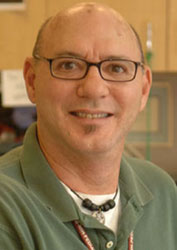 |
Ric Runnells
At the Clinical Center since 2000
Job: research support assistant, Nursing and Patient Care Services
|
To the children in the pediatric day hospital, he’s known as “Mr. Ric,” because, he says, first names are more personable.
Ric “Mr. Ric” Runnells is a research support assistant with Nursing and Patient Care Services who sits at the desk in the middle of the day hospital hubbub. He provides administrative support and much more to the staff, patients, and their families.
Runnells has been at the Clinical Center since 2000. He has spent his entire career working in hospitals. He says he’s drawn to the “warmth and compassion you can express to families and the staff.” When a family walks into the unit, or calls on the phone, he’s quick to greet them with “May I help you?” He takes care of their needs inside the hospital and helps them handle the downtime. Families come to him for suggestions on sights to visit and places to eat. He arranged for Where magazine, a city guide, to be delivered to the unit for families from outside the Washington area. “Doctors who don’t even have patients in the day hospital will send people to me for information,” he says with a grin.
“I love my job. I look forward to coming to work and to getting to know the patients. Each person who walks through the door brings a new experience.” He says he learns about their countries and culture and shares in their excitement about being in Washington and their gratitude at finding a treatment. “I’m just a person who likes to help anyone,” he explains, while quickly noting he does not do it alone. “I believe we are one big team.”
Back to Top
Massive and realistic drill
Nearly 100 moulaged “victims” were triaged and transported to medical facilities by ambulances and helicopters during a regional emergency drill on Dec. 7. It was the largest multi-agency medical exercise sponsored by the Bethesda Hospitals’ Emergency Preparedness Partnership. The partner organizations—the NIH Clinical Center, Suburban Hospital, and National Naval Medical Center—conduct the annual drill to test the regional interoperability of local, state, and federal emergency management agencies.
More than 8,000 people around the region took part in this year’s drill, including participants from Joint Forces Headquarters, West Virginia National Guard units, Air Force District Washington, and Montgomery County Fire and Rescue Services. The scenario was based on a simulated fuel explosion and an already depleted hospital system in the D.C. area. Most of the drill activity was conducted at NNMC. The Bethesda Hospitals’ Emergency Preparedness Partnership is a first-of-its-kind collaboration that links military, federal, and private mass-casualty medical responses within the National Capital Area. Started in 2003 and formalized in 2005, the partnership is now a model for other health-care agencies throughout the country.
Back to Top
Hamlisch offers holiday concert for Safra Lodge guests
 |
National Symphony Orchestra Principal Pops Conductor Marvin Hamlisch (center) entertained guests at the Safra Family Lodge along with opera singer Angela M. Brown and trumpeter Brandon Ridenour.
|
National Symphony Orchestra Principal Pops Conductor Marvin Hamlisch turned a Saturday morning into a special event for people at the Safra Family Lodge. He put on a holiday concert Dec. 9 for lodge guests and their loved ones who are receiving treatment at the NIH Clinical Center.
For nearly an hour, the audience was treated to holiday music and a sampling of Hamlisch hits from movies and Broadway. Opera singer Angela M. Brown and trumpeter Brandon Ridenour also performed. All three were in town for a series of “Happy Holidays” concerts at the Kennedy Center.
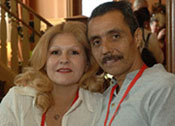 |
Herminio Calderon and Olga Lopez enjoyed the performance.
|
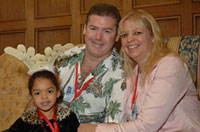 |
Paul McNaughton, Jr., Shelley Gregory, and daughter Jazmine were among those in the audience.
|
“It was very touching. It was hard to hold back tears,” said lodge guest Olga Lopez of Angleton, Texas. She was in the middle of a four-day visit with her fiance, Herminio Calderon. The concert and reception that followed gave the two some quality time together—a date of sorts. Calderon said he really enjoyed the concert. He said his visit to the lodge was his first time out since his arrival at the CC three weeks earlier.
This was the second year Hamlisch put on a holiday show at the lodge. “We look forward to coming here,” he told the audience. “You are inspirational to us.” Hamlisch said his sister and mother died of cancer and the concert is a way for him to give back. “As long as I can keep doing this, I will.”
Paul McNaughton, Jr., a patient from Honolulu, Hawaii, watched the concert with his fiancée, Shelley Gregory, and their daughter Jazmine. “Once again, the lodge has gone above and beyond,” he said. The family came to NIH at the end of October and was preparing to leave a few days after the concert. McNaughton and Gregory both noted how much the lodge did for them during their long stay. Staff brought in their children so Jazmine could have some playmates, and a party for Jazmine was in the works if the family wasn’t able to return to Hawaii in time for her birthday. “It’s hard when you are away from home this long and routines are broken,” McNaughton said. “This whole facility has been a gift, a blessing.”
– Shana Potash
Back to Top
CIST program provides unique learning experience for students
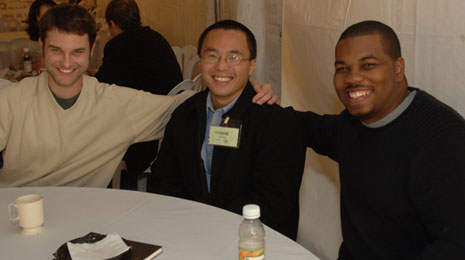 |
(From left) HHMI fellows Eric Buras, Tho Pham, and Jameel Johnson share ideas over breakfast.
|
They came to NIH at a pivotal time in both their careers and the field of medicine. And some had what you might call an “aha” moment.
Approximately 250 medical and dental students from across the country recently attended the Fourth Annual Clinical Investigator Student Trainee (CIST) Forum at the NIH Clinical Center. The forum is designed for students who are participating in clinical and research fellowships at academic medical centers and NIH and is structured to further engage and encourage them to become the next generation of clinician-scientists. The two-day event included presentations by well-known researchers from inside and outside the NIH and gave students the opportunity to network with their peers and with established clinical investigators.
“In the last few years it has become clear that medicine is changing. And, NIH Director Dr. Elias Zerhouni has pointed out it is going to change in fairly dramatic ways in the coming generation,” Dr. Michael M. Gottesman, NIH deputy director for intramural research, said during opening remarks. Gottesman described what Zerhouni calls the three “p’s” that will characterize medicine in the future. It will become more personalized, predictive and pre-emptive. Each patient will have more molecular and cellular analyses of their specific disease so the medical community can predict what’s going to happen with the disease and pre-empt, as much as possible, the development of serious disease.
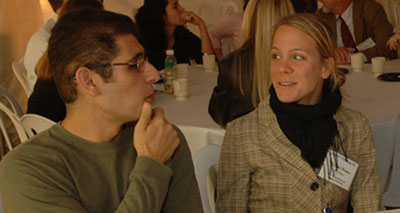 |
CIST forum attendees Mani Foroohar, an HHMI fellow, and Kristin Weeks, a CRTP fellow, discuss research interests.
|
“You really are the shock troops for this transformation,” Gottesman told the students. “You are the people in the next generation who are going to work in the labs, work in the clinics, and figure out how to change the face of medicine. Therefore, this program is extremely important to the NIH.”
Minutes into the forum, students were learning about recent advances in translational research from prominent scientists, including two from the National Cancer Institute. Dr. Steven A. Rosenberg, chief of the surgery branch and head of its tumor immunology section, discussed his pioneering work in immunotherapy, a new approach to treating cancer in which researchers attempt to alter the body’s own natural immune defenses to fight the disease. Dr. Elise C. Kohn, head of the molecular signaling section in the laboratory of pathology and acting director for the Medical Education Program, addressed diagnostic and therapeutic developments in the treatment of ovarian cancer, which is her research interest.
Kohn said she hoped that students attending the forum would become even more excited about medical research and would recognize the NIH as a formidable location for advancing their training and ideals. When asked what she hoped students would get from her, Kohn quickly responded, “enthusiasm and drive, and maybe an interest in oncology.”
HIV-AIDS, lipids and atherosclerosis, asthma and sickle cell disease, and Helicobacter pylori in human disease and health were among the other bench-to-bedside research topics presented. There also were discussions on bioethics, loan repayments and grants, the physician-scientist career path, and a keynote address by Dr. Francis Collins, director of the Human Genome Research Institute.
“The speakers are so encouraging. They keep telling us ‘You are the future of biomedicine,’” said Kristin Weeks. She is the first student from the University of Kentucky College of Medicine to be a fellow with the Clinical Research Training Program (CRTP) at the NIH.
Gregory Nelson, from Yale University School of Medicine and a fellow with the Howard Hughes Medical Institute (HHMI), echoed that sentiment, “It’s invigorating to imagine what’s ahead.” He said the physician-scientists at the forum gave the students encouragement and support to find their niche and not prematurely decide the road is too hard.
During the session “How to Succeed as a Physician-Scientist,” Nelson asked the panelists whether anyone, with hard work and passion, can successfully pursue this career. “With hard work anyone can achieve anything,” responded panelist Dr. Pamela Lipsett. “I do believe in the American dream.” Lipsett was the first woman to become a full professor of surgery at Johns Hopkins School of Medicine.
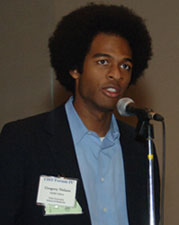 |
HHMI fellow Gregory Nelson solicits the opinions of panelists during the session, “How to Succeed as a Physician-Scientist.”
|
Another member of that panel, Dr. Peg Nopoulos, a professor of psychiatry at the University of Iowa, noted that opportunity is ripe for the students because there is a need for physician-scientists. “This is a very important time,” she told the students, “I can guarantee you that if you are a student who has a strong interest in being an academic scientist, people all around the country are going to be interested in you for their residency and training programs.”
Dr. Frederick P. Ognibene, CRTP director and one of the organizers of the CIST forum, says data indicate the number of physicians going into academic or research careers is falling somewhat, so the forum was about much more than learning. “It also was an attempt to continue to keep the passion they have in clinical research an active passion—to let them know this is an interesting, exciting, and viable career,” said Ognibene.
The students also were encouraged to find the right mentor, and to connect with the other students at the forum. The latter was emphasized by CC Director Dr. John I. Gallin when he welcomed the students to the CC and the forum. “You’ll be meeting for the first time some people who will undoubtedly influence your careers. Don’t underestimate the role of your peers in your career development as you move forward.”
That point was not lost on Bahar Mojgani from Georgetown University School of Medicine and the General Clinical Research Centers of the National Center for Research Resources. “It’s exciting being in a room with so many young people who are going on the same career path as you and knowing that one day you may get to collaborate with them.”
“For me, the most interesting thing has been talking to other students, hearing about how they approach scientific problems,” said Eric Buras, from Baylor College of Medicine and a Howard Hughes Medical Institute fellow. Buras said he has already decided to become an endocrinologist and a physician-scientist, but he liked learning about new fields and the career directions other students are taking.
A student who said he was concerned that he had too many interests and no focus, had a defining moment at the forum. Alexander Diaz de Villavilla, a Yale med student and HHMI fellow, said “The forum was helpful in that I got exposure to what top researchers are doing and I realized many are multidisciplinary. I wasn’t expecting that, so it was encouraging to me.”
CIST Forum participants include Howard Hughes Medical Institute Scholars (Cloister) and Fellows (non-Cloister), Doris Duke Clinical Research Program Fellows, Fogarty International Center-Ellison Medical Foundation Overseas Fellows, General Clinical Research Centers of the National Center for Research Resources Medical Students, NIH Clinical Research Training Program Fellows, Sarnoff Cardiovascular Research Foundation Fellows.
Back to Top
Gingerbread house competition stirs up creativity and excitement
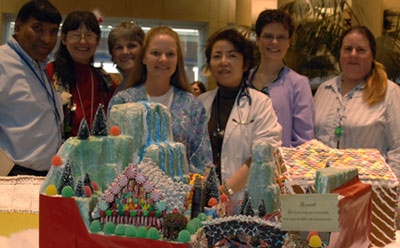 |
First place went to 5NW. Representing the team at the announcement (from left) Subramania Varadarajan, Diana Chepurko, Noreen Giganti, Joyce Linderman, Yumi Lee, Catherine Seamon, and Lisa Twedt. Not pictured is gingerbread house designer Philip Bernaldez.
|
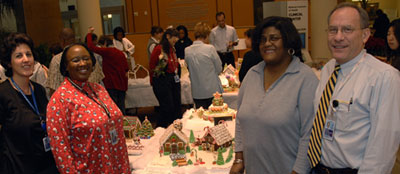 |
Second place went to the Department of Laboratory Medicine, Chemistry. Representing the team (from left) were Tracy Bosworth, Sheila Connors, Michelle George, and Sam Stenach, Jr.
|
 |
The contest is organized by the recognition and retention committee of Nursing and Patient Care Services. From left are Ann Marie Matlock, Twanda Scales, Madeline Cooper, Caroline Stewart, Rosa Clark, Liccey Clavell, Nikkia Powell, Tanjalle Simon, Babbi Babilonia-Ayukawa, Allison Adams-Mclean, Kim Pinkney, Cynthia Herringa, Lenora Jones, Kim Scott, Sherria Washington, Tannia Cartledge, Jeff Aberle, Carol Levinson, and Julie Kohn.
|
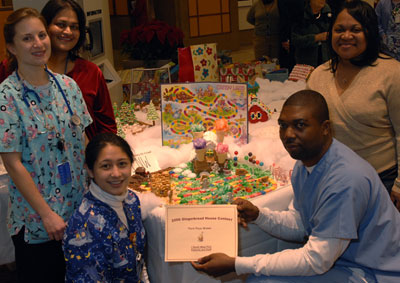 |
Third place went to 1NW inpatient unit whose entry was made by both pediatric patients and staff. Representing the team (from left to right) Gaynell Amaya, Jean Perrelli, Ashleigh Hussey, Anthony Terry, and Felicia Andrews.
|
The annual gingerbread house decorating contest drew long lines and lots of oohs and aahs from patients, visitors, and staff.
Twenty-eight houses created by staff representing a dozen different departments were on display in the atrium of the Clinical Center lobby in December. The contest attracted so much interest that more than 1,900 ballots were cast during the week the houses were on display.
The Recognition and Retention Committee of Nursing and Patient Care Services started the contest three years ago, with nursing units participating. It was open to all CC staff the next year. Organizers and participants say the entries get more elaborate each year.
“I had people coming up to me in the summer and telling me they’re already planning their gingerbread house,” says Ann Marie Matlock, nurse manager on 5SE. She chairs the gingerbread house committee.
Sheria Washington, a program support specialist with Nursing and Patient Care Services, worked with colleagues to plan their entry, “Santa’s Casino.” Washington says they came up with their theme as last year’s contest ended. “We looked around for something no one else did and then started collecting items for the display.”
The contest is another outlet for the creative thinking and collaborative spirit of workers throughout the CC. Contestants have only a few rules to follow: they must use the gingerbread house in the kit that is provided; the display can not be any bigger than a two-foot-by-two-foot platform; and no electricity may be used, but batteries are allowed.
Workers on 1NW day hospital created a winter wonderland. Kathleen Beville was the major designer. She started baking pieces of the display back in November. The entry from 1NW won first prize last year so, Beville says, “the pressure was on.”
Other entries included a Lord of the Rings display, a re-creation of NIH Building 1, a patriotic salute to American troops, and a tribute to CC teamwork by social workers titled “It Takes a Village.”
Several sections of the Department of Laboratory Medicine entered houses. Suzanne Albright, a technologist, was one of about 10 people to work on the entry by the chemistry section. “None of us have ever done this before, but we have a lot of creative people in chemistry,” she said. Their display ended up taking second place.
People passing through the neighborhood of gingerbread houses marveled at the construction techniques and tools. There were roofs made of cereal, candy wafers and gum; doors designed from chocolate bars and graham crackers; pretzel fences; and spearmint leaf trees.
After the contest, the houses were donated to the Children’s Inn and the Safra Famly Lodge.
—Shana Potash
Back to Top
Upcoming Events
Clinical Center Grand Rounds and Great Teachers Lectures
Wednesday, January 3
Immunology of Hepatitis C
Barbara Rehermann, M.D.
Chief, Immunology Section, Liver Diseases Branch, NIDDK
Clinical Aspects of Hepatitis C
Theo Heller, MB.BCh.
Staff Clinician, Liver Diseases Branch, NIDDK
Wednesday, January 10
Contemporary Clinical Medicine:
Great Teachers
Insulin Action and Developmental Genes in Adipose Tissue and Aging
C. Ronald Kahn, M.D.
President and Director, Joslin Diabetes Center
Mary K. Iacocca Professor, Harvard Medical School
Lecture will be videocast, http://videocast.nih.gov
Wednesday, January 17
Fibrous Dysplasia of Bone: A Skeletal Stem Cell Disease
Pamela Gehron Robey, Ph.D.
Chief, Craniofacial and Skeletal Diseases Branch, NIDCR
Fibrous Dysplasia of Bone: Natural History, Treatment, and Insights Into Mineral Metabolism
Michael T. Collins, M.D.
Tenure-Track Investigator and Chief, Skeletal Clinical Studies Unit, Craniofacial and Skeletal Diseases Branch, NIDCR
Wednesday, January 24
Septic Shock Therapeutics: Detours and Paths to Improved Outcomes
Charles Natanson, M.D.
Senior Investigator, Critical Care Medicine Department, CC
Anthony F. Suffredini, M.D.
Senior Investigator, Critical Care Medicine Department, CC
Wednesday, January 31
Metastasis: Biology and Therapy
Lee J. Helman, M.D.
Scientific Director for Clinical Research, Center for Cancer Research, NCI
Chand Khanna, D.V.M., Ph.D.
Head, Tumor and Metastasis Biology Section, Pediatric Oncology Branch, and Director, Comparative Oncology Program, Center for Cancer Research, NCI
Back to Top
Clinical Center News, National
Institutes of Health, Building 10, 10 Center Drive, Room 12C440, Bethesda, MD 20892-1504. Tel: 301-496-6787.
Fax: 301-402-2984. Published monthly for CC employees
by the Office of Communications, Patient Recruitment, and Public Liaison. News, article ideas,
calendar events, letters, and photographs are welcome.
Back to Top
|
|


 The information on this page is archived and provided for reference purposes only.
The information on this page is archived and provided for reference purposes only.